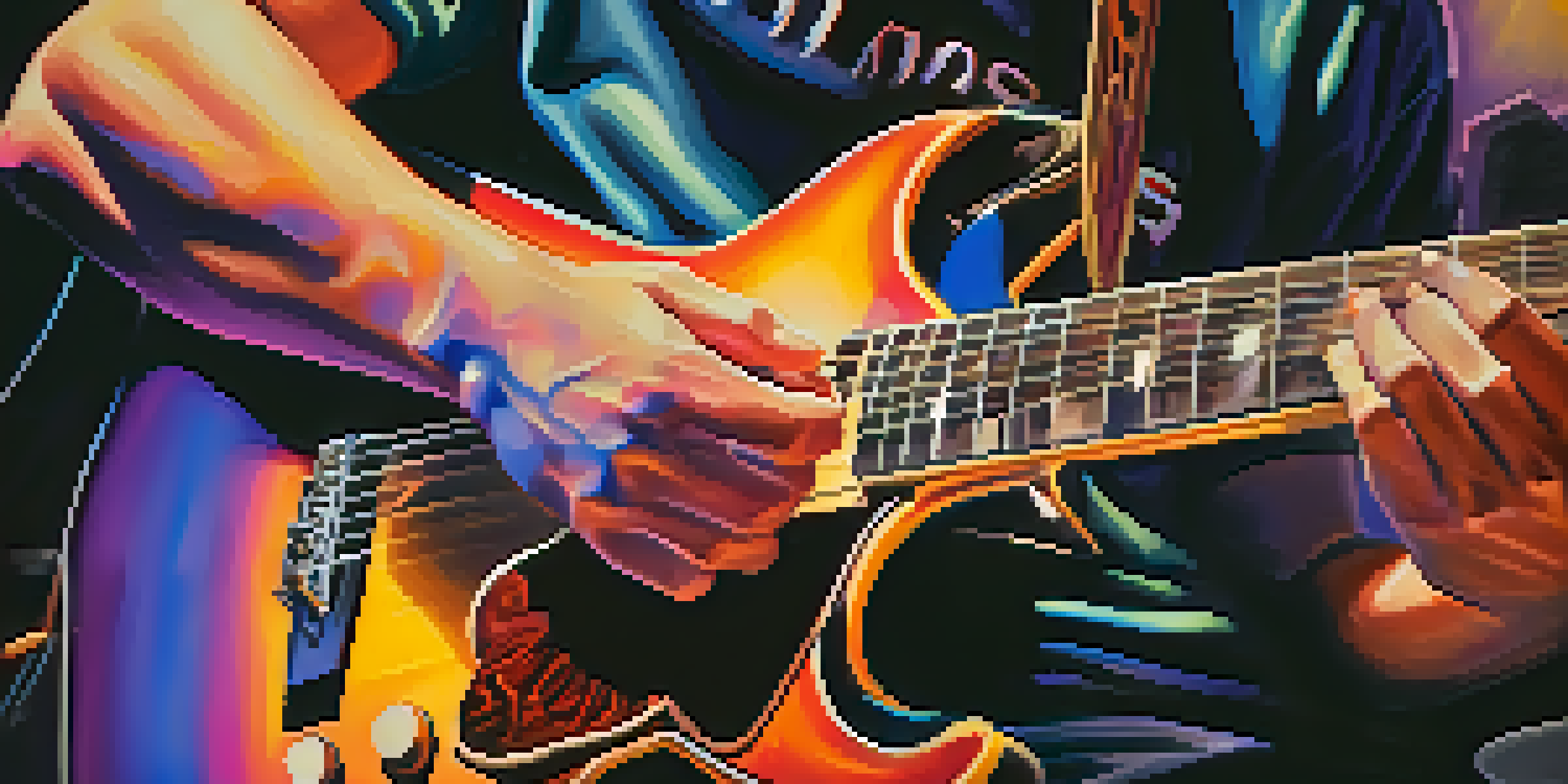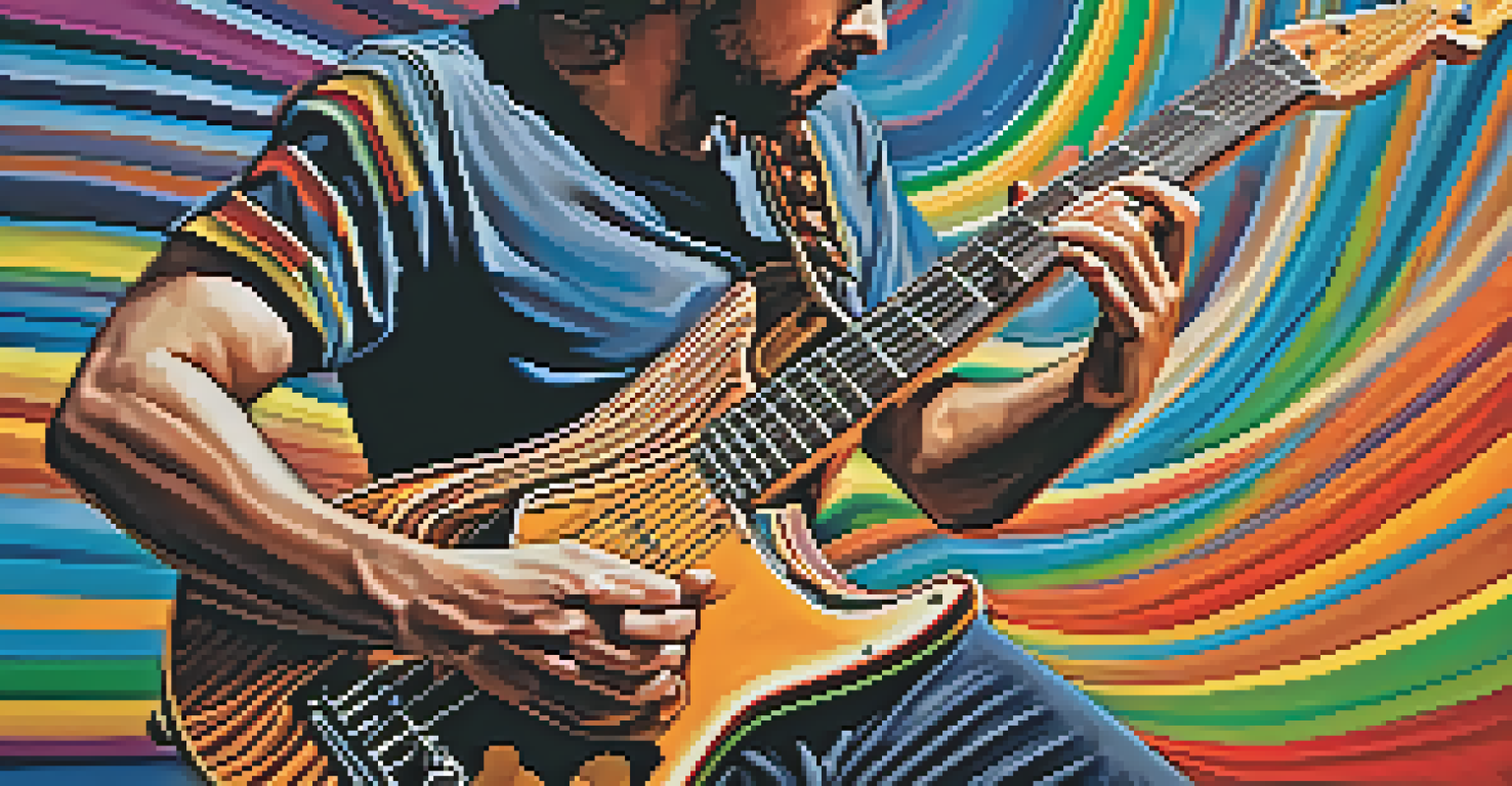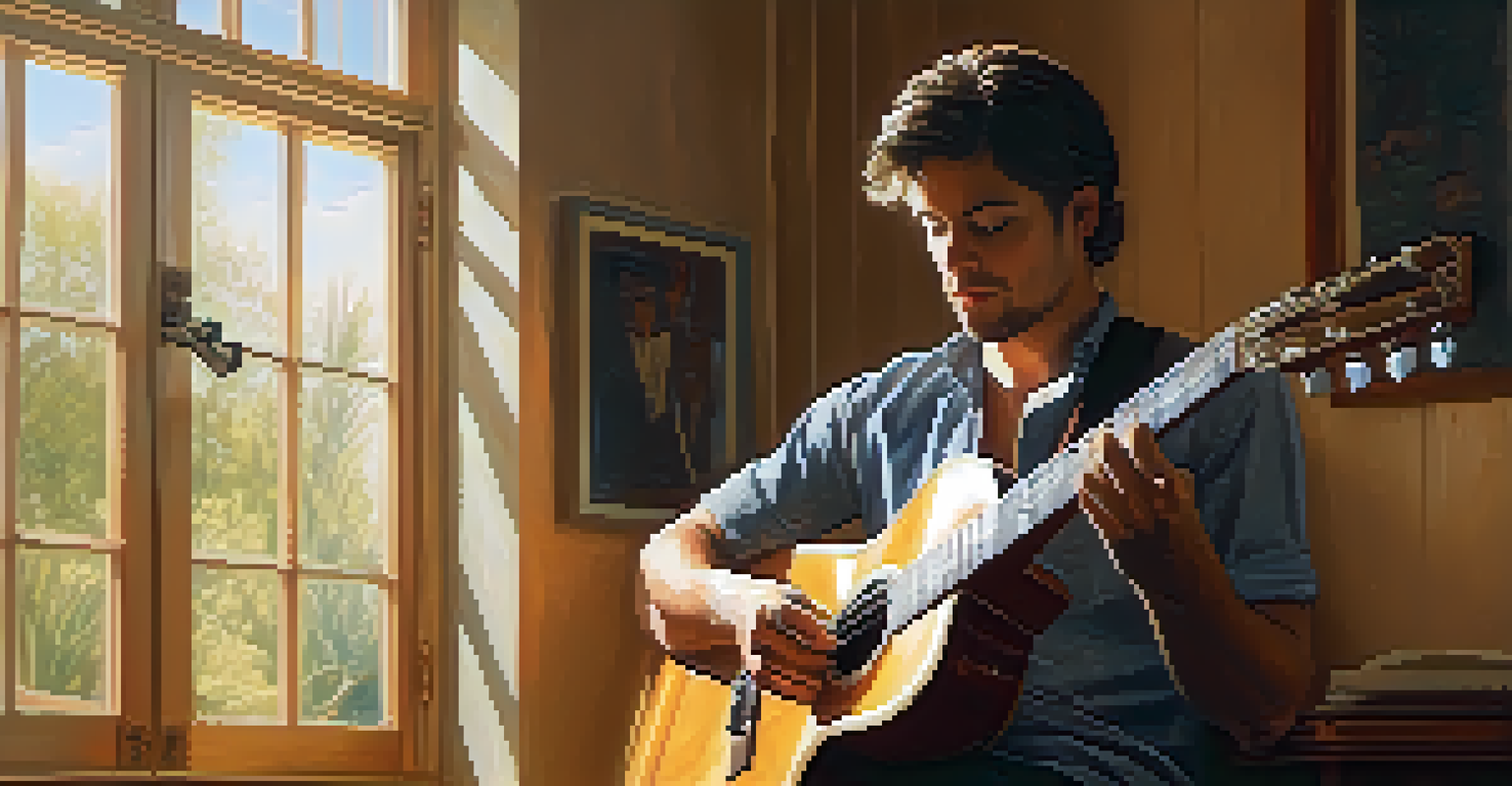Percussive Guitar Techniques for Rhythmic Creativity

Understanding Percussive Guitar Techniques
Percussive guitar techniques blend melody and rhythm in a unique way, transforming a traditional guitar into a rhythm powerhouse. This style emphasizes the use of the body of the guitar, strings, and even the player's hands to create striking sounds that go beyond simple chord progressions. By incorporating techniques like slapping, tapping, and palm muting, guitarists can add layers of texture to their music, making it more dynamic and engaging.
Music is the shorthand of emotion.
To put this into perspective, think of a percussive guitar as a drummer and a guitarist rolled into one. This dual role allows musicians to maintain a steady beat while simultaneously playing melodies or harmonies. Just like a drummer uses various parts of the drum kit to create different sounds, guitarists can explore their instrument in innovative ways that highlight its percussive capabilities.
Essentially, percussive guitar techniques encourage players to think outside the box. They invite creativity and experimentation, which can lead to fresh sounds and styles that set your music apart. Whether you’re a seasoned player or just starting out, understanding these techniques is the first step toward unlocking your rhythmic potential.
The Basics of Slapping and Popping
Slapping and popping are foundational percussive techniques that can instantly elevate your guitar playing. Slapping involves striking the strings with your thumb, generating a sharp, percussive sound, while popping is achieved by pulling the strings and letting them snap back against the fretboard, creating a bright, snappy tone. Together, these methods create a dynamic rhythmic groove that can drive your music forward.

Imagine the excitement of a lively jam session where the sound of slapping and popping fills the room. It's infectious! When you incorporate these techniques, you can easily engage your audience, drawing them into the rhythm and energy of your performance. This style not only enhances your technical skills but also invites your listeners to feel the groove with you.
Percussive Techniques Enhance Rhythm
Incorporating techniques like slapping, tapping, and palm muting transforms the guitar into a dynamic instrument that blends melody and rhythm.
To get started, practice slowly, focusing on timing and accuracy. As you become more comfortable, gradually increase your speed and complexity. Slapping and popping can be used in various genres, from funk to rock, making them versatile tools in your musical arsenal.
Tapping: Expanding Melodic Possibilities
Tapping is another exciting percussive technique that allows guitarists to expand their melodic possibilities. By using both hands on the fretboard, players can create rapid sequences of notes that sound complex and fluid. This method is particularly effective for playing intricate solos or harmonies, giving the impression of multiple instruments working together.
The rhythm is going to get you.
Picture a painter using different brushes to create layers and depth in a piece of art. Similarly, tapping adds depth to your guitar playing by enabling you to weave in various melodic lines over a rhythmic foundation. This technique can also spark new musical ideas, pushing you to explore sounds you might not have otherwise considered.
When practicing tapping, focus on clean execution and synchronized timing between your hands. As you develop your skills, don’t hesitate to experiment with different patterns and rhythms. The beauty of tapping lies in its adaptability, allowing you to blend it seamlessly into various musical styles.
Palm Muting for Subtle Rhythmic Effects
Palm muting is a subtle yet powerful technique that adds depth to your rhythmic playing. By resting the edge of your palm on the strings near the bridge while strumming or picking, you can create a muted, percussive sound that enhances the overall groove. This technique is especially effective in creating tension and dynamics within a song.
Think of palm muting as a seasoning in cooking. Just a pinch can enhance the flavors of a dish, making it more enjoyable. Similarly, palm muting can add variety and interest to your guitar parts, breaking up the monotony of straightforward playing. It’s an essential tool for any guitarist looking to refine their rhythm.
Rhythm Drives Musical Composition
Focusing on rhythm allows guitarists to experiment with timing and syncopation, creating compositions that resonate deeply with listeners.
To master palm muting, practice varying the pressure and position of your palm to achieve different tones. Combining palm muting with other techniques like strumming or fingerpicking can lead to unique rhythmic patterns that keep your playing fresh and engaging.
The Role of Rhythm in Composition
Rhythm is the heartbeat of music, providing structure and flow that guide the listener's experience. In percussive guitar playing, rhythm takes center stage, allowing composers to experiment with timing, syncopation, and accents. By focusing on rhythm, guitarists can create compositions that resonate more deeply with audiences.
Think of a dance floor filled with people moving to the beat. The rhythm draws them in, making them feel connected to the music. When you incorporate percussive techniques into your compositions, you create a similar effect, inviting listeners to engage with your music on a physical and emotional level.
As you write your own pieces, pay attention to how rhythmic variations can enhance your melodies. Experiment with different time signatures, syncopated rhythms, and percussive techniques to find a unique voice that reflects your style and creativity.
Incorporating Percussive Techniques into Your Playing
Incorporating percussive techniques into your playing can feel daunting, but with practice and patience, it becomes second nature. Start by selecting a few techniques that resonate with you, such as slapping, tapping, or palm muting, and integrate them into your existing repertoire. This gradual approach allows you to build confidence while expanding your musical vocabulary.
Consider your favorite songs or artists who utilize percussive elements. Analyze their techniques and try to replicate them in your own style. This not only hones your skills but also inspires creativity as you adapt their ideas into your unique sound.
Creative Expression Through Rhythm
Mastering percussive techniques empowers musicians to convey emotions and stories, turning the guitar into a powerful vehicle for artistic connection.
As you practice, don't shy away from improvisation. Allow yourself to experiment with different rhythms and techniques in a free-form style. This exploration is vital for developing your own voice as a guitarist and unlocking the full potential of percussive playing.
The Journey of Creative Expression Through Rhythm
The journey of mastering percussive guitar techniques is ultimately about creative expression. As you explore these methods, you’ll find that they enable you to convey emotions and stories through rhythm. The guitar becomes more than just an instrument; it transforms into a vehicle for artistic expression and connection with your audience.
Think about how a powerful rhythm can evoke feelings of joy, sadness, or excitement. As you incorporate percussive techniques into your playing, you’ll discover that your music can resonate on a deeper level, allowing listeners to feel what you’re expressing. This connection is what makes music such a powerful force in our lives.

Remember, the path to mastery is not a race. Embrace the learning process, celebrate your progress, and keep experimenting with different techniques. Through rhythm and creativity, you’ll not only enhance your guitar skills but also establish your identity as a musician.